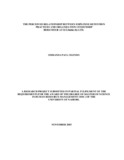| dc.description.abstract | The objective of this study was to establish the relationship between employee retention
practices and OCB at D.T.Dobie (K) Limited. The factors explored on retention practices were
Recruitment and selection, Realistic Job Preview, Corporate Image, Organizational Culture,
Leadership style, Employee Relations, Communication, Reward and Recognition, Training and
Development, Work Life Balance and Geographical Location/Transfers. The study then explored
the intervening relationship of OCB factors thus; Helping Behaviours/ Altruism, Sportsmanship,
Loyalty/General compliance, Conscientiousness/ Individual imitative, Civic Virtue and
Courtesy. The study population comprised of all the D.T.Dobie staff that were present at the
time of data collection in July 2015. A sample of 151 respondents was selected from the
population using Stratified Random sampling method that captured 30% of the total population
in the ratio of 3.1 with representation from all categories of employment. A descriptive research
design was used. Primary data was collected using five point Likert scale design questionnaires
with varying degrees of measurement from strongly disagree to strongly agree. Data was
analyzed using descriptive statistics and inferential statistics. The study revealed the relationship
between recruitment and selection practice and conscientiousness dimension was statistically
significant. The study showed that Realistic Job Preview practice significantly contributes to
existence of OCB dimensions thus Loyalty, conscientiousness and civic virtue of employees.
The other retention practices; Organizational culture and employee relations, leadership styles
showed equally significant relationship with OCB dimensions. The study revealed that there is a
significant relationship between employee retention practices and OCB dimensions and is an
indication that progressive and attractive employee retention practices are linked to OCB
dimensions and contribute to employee retention at D.T.Dobie. The study also concluded that
employees’ dissatisfaction with retention practices and OCB dimensions at D.T.Dobie is major
cause of employees’ exits from the organization. Additionally the study revealed that retention
practices have a positive influence on OCB dimensions. The study has made contribution to
theory, policy and practice in relation to employee retention practices and OCB dimensions in
the quest to retain employees. The study therefore offered further clarification into the
relationship between employee retention practice and OCB. The limitations of this study arose
from the selection of study variables, the scope of the study which involved one organization
only and use of a single informant approach which deprived broad base information access.
Lastly the study recommended future research should seek to address these limitations by
inclusion of additional factors, expanding the scope of the study to include NGOs, Government
institutions and SMEs and thus compare results similarities across the board. That could serve as
a useful reference for future research. | en_US |

